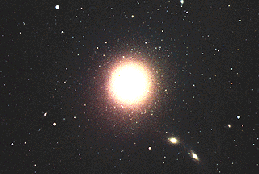 |
||
| First page | ||
 |
||
| Milky way | ||
 |
||
| Spiral galaxies | ||
 |
||
| Elliptical galaxies | ||
 |
||
| Irregular galaxies | ||
 |
Quasars | |
 |
||
| Find out more | ||
 |
||
 |
||
 Elliptical galaxies are spherical or ellipsoidal systems that don't have spiral arms or a disk, or even any significant amount of interstellar gas or dust. They contain mostly old stars and their light is dominated by red stars (read more about different stars in our star tutorial). The mass of the stars in giant ellipticals is typically at least a million million times the mass of the Sun.
Elliptical galaxies are spherical or ellipsoidal systems that don't have spiral arms or a disk, or even any significant amount of interstellar gas or dust. They contain mostly old stars and their light is dominated by red stars (read more about different stars in our star tutorial). The mass of the stars in giant ellipticals is typically at least a million million times the mass of the Sun.
In size, elliptical galaxies are everything from dwarfs to giants and their shape can be anything from almost spherical to almost flat. The largest known galaxies are elliptical and they are also more massive than most spiral galaxies. It seems as if 1-2% of their total mass is in the form of gas at a very high temperature (more than a million degrees). These large galaxies extend over at least several hundred thousand light years and are a lot larger than the largest spiral galaxies. In the dwarf ellipticals there are so few bright stars that even the central regions are transparent. Most stars are probably too faint for us to see and even a dwarf elliptical contain at least several million stars.
All in all most galaxies are dwarfs and the majority of dwarf galaxies are elliptical, including our nearest neighbour galaxy. Most large elliptical galaxies are found in the cores of rich galaxy clusters.
26th July 2000
Sarah Amandusson
www_astro@mssl.ucl.ac.uk